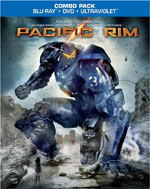
Pacific Rim

 – for sequences of intense sci-fi action and violence throughout, and brief language.
– for sequences of intense sci-fi action and violence throughout, and brief language.
Director: Guillermo del Toro
Starring: Charlie Hunnam, Idris Elba, Rinko Kikuchi, Charlie Day, Burn Gorman, Max Martini, Clifton Collins Jr., Ron Perlman
Running Time: 2 hours, 12 minutes
Theatrical Release Date: July 12, 2013
Official Site
Blu-Ray Release Date: October 15, 2013 (Amazon.com)
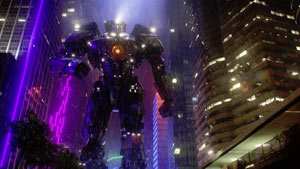
Plot Summary
When legions of monstrous creatures, known as Kaiju, started rising from the sea, a war began that would take millions of lives and consume humanity’s resources for years on end. To combat the giant Kaiju, a special type of weapon was devised: massive robots, called Jaegers, which are controlled simultaneously by two pilots whose minds are locked in a neural bridge. But even the Jaegers are proving nearly defenseless in the face of the relentless Kaiju. On the verge of defeat, the forces defending mankind have no choice but to turn to two unlikely heroes—a washed up former pilot (Charlie Hunnam) and an untested trainee (Rinko Kikuchi)—who are teamed to drive a legendary but seemingly obsolete Jaeger from the past. Together, they stand as mankind’s last hope against the mounting apocalypse.
(from MovieWeb.com)
Film Review
Trailers can make or break a movie. And with a film like Pacific Rim, it would seem like the right trailer would be a tough one to make. How do you market an outrageous monster/action movie to audiences who are becoming increasingly harder to please? There are elements to the trailers that were most seen in theaters for this movie that were so over-the-top that they seemed appealing from an entertainment standpoint, but it was difficult not to shake your head and laugh at the visuals on screen and the words being spoken over them. “To fight monsters, we created monsters of our own,” was a line heard in voice over by a dramatically deep male voice. And as the shot of a gigantic robot wielding an ocean liner as a baseball bat to hit an equally gigantic monster was shown, you’re not sure whether to roll your eyes or buy a ticket. By the time the film’s release date rolled around, this reviewer had decided to wait to see what other critics were saying. To my surprise, the majority were in favor of the action film, going so far as to say it was one of the best action/destruction movies in years. And with that, we decided to check in to the movie in its IMAX 3D form.
When a movie is in the aspect ratio of 1.85:1 and shown on an IMAX screen, it just about fills the entire screen on its own without having to have been shot specifically for IMAX. So when you’ve got a movie like this one — larger-than-life robots battling larger-than-life monsters — it’s the perfect movie to see on a ceiling-to-floor screen. Pacific Rim is a movie made with the sole purpose to entertain and with that, it certainly delivers. The IMAX showing is also in 3D (with no 2D options, unlike Man Of Steel), and the 3D looked pretty good. I still am not a firm believer in the use of 3D these days, as I think most of it doesn’t even look 3D. It really only seems to stand out during perspective shots or the few times they even bother to make something jump out of the screen instead of recede into it. Still, sometimes the 3D can detract from the movie, and I actually didn’t find that to be the case for Pacific Rim. If anything, I felt it was ideal to see the movie on IMAX.
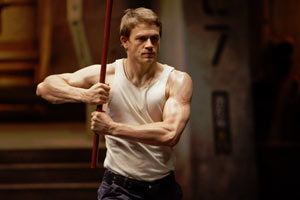
The movie itself brings to mind the kind of 90s apocalyptic, large-scale disaster flicks like Independence Day or the 1998 Godzilla. Director Guillermo del Toro, who’s probably most known for the Hellboy franchise and the 2006, R-rated Pan’s Labyrinth, helms this monster movie that begins in the midst of a war the humans have been raging with gigantic alien beasts for years now. The movie opens with a brief history of how aliens came from deep within the earth via a portal of sorts and periodically attack cities with the intent to annihilate humankind as we know it. del Toro does a nice job creating a lore and background for these creatures, while also creating a “near future” where battling these beasts, and surviving, has become a way of life for us. The monsters have been dubbed by the people as the Kaiju, and mankind decides to put aside their differences and unite to build humongous robots called Jaegers (pronouned “Yaegers”). These robots are piloted by two people who literally sync up their brains so they share the same thoughts and memories. It allows them to be able to control the robots together. This introduces us to Raleigh Becket, played by Charlie Hunnam from the show Sons of Anarchy (although, I’ve never seen him in anything before, so he just seems a lot like a blend of Channing Tatum and Garrett Hedlund to me), who is considered one of the best Jaeger pilots alongside his older brother. In the film’s opening scenes, we see a Kaiju nearly destroy Becket’s Jaeger, Gipsy, but kills Raleigh’s older brother in the process. The movie then fast-forwards 5 years later where we see that Raleigh has been trying to live his life as a former Jaeger pilot but gets recruited back into the program by his captain, Stacker Pentecost, played by Idris Elba (Thor, The Losers, Season 6 of The Office). From there, the story actually revolves around the characters more than you might think as Raleigh struggles to overcome the loss of his brother and get back into the game by finding a new Jaeger co-pilot. Meanwhile, a team of scientists are brought in to find out more about the Kaiju and how they can be stopped. One of them, Dr. Newton Geiszler, played by Charlie Day (TV’s It’s Always Sunny in Philadelphia), becomes obsessed with neurally exploring the mind of the Kaiju. Between these scientific explorations and Raleigh’s return to the frontlines, it seems as if the war with the Kaiju may finally be coming to an end.
The story is unique and del Toro explains enough about what’s happened and what’s going on along the way to keep us all in the loop (although, so much is thrown at us all at once that it’s tough to absorb everything in one viewing). There are certainly elements about the story and characters that will feel familiar, but overall, it’s a pretty original concept. The biggest problem the film may suffer, however, is the absence of some really strong actors. The cast is primarily made up of B-list actors which makes the film feel even more so like a Saturday matinee B-movie. Hunnam looks and sounds like a Tatum/Hedlund hybrid (both of which I wouldn’t consider the strongest lead actors to begin with) which makes him feel like a second string player placed in the lead spot, but surrounding him with some decent players, like the reliable Idris Elba for example, helps carry the acting portions of the movie a little bit better. Hunnam proves to be watchable and relatable enough that he, at the very least, never reaches a level of mediocrity that someone like Taylor Kitsch tends to. The only significant female presence in the film is given to Rinko Kikuchi (The Brothers Bloom), who plays Mako, and isn’t the best choice for a female lead, but she works well for what the movie calls for with her role and she actually has some chemistry (albeit only a little) with Hunnam. The characters of Charlie Day as Dr. Geiszler and Burn Gorman (The Dark Knight Rises) as Gottlieb are one of the biggest iffy character decisions. Day plays Geiszler as completely nerdy and neurotic, while Gorman plays Gottlieb only slightly less neurotic and incredibly more twitchy. Day especially borders on completely annoying for most of his scenes that I found myself almost rooting for the Kaiju to take him out. del Toro ended up giving his character a bit too much screen time, too, while his Hellboy lead actor Ron Perlman got considerably less screen time but essentially played another flamboyant, cartoonish kind of character (like Geiszler). If you remove the Jaegers and Kaiju from Pacific Rim, it’s the kind of film the Mystery Science Theater 3000 cast might have a field day with (and their alumni who carry on RiffTrax online still might anyway), but coupled with the monsters, robots, and action, it still all works surprisingly well as just a big, loud, fun action movie. del Toro spends enough time developing his main characters that, by the time the final blows in the film are dealt, you honestly care about what might happen to them.
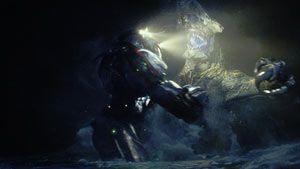
While I’m curious as to how the characters will hold up with repeat viewings, the story, special effects, and action in Pacific Rim are quite strong. With a movie like this one, the premise alone is cause for checking your disbelief at the door, but del Toro takes care to not just expect viewers to embrace anything and everything without explanation. And it’s that attention to detail that helps raise Pacific Rim above other disaster/monster/destruction films. The mere fact that del Toro isn’t shoving a political or moral agenda down the audience’s throats sure helps the matter too. The monster designs are unique, the robots are pretty cool (even if Gipsy seems like it rips some off its likeness from Iron Man a little too much), and the action is engaging. It’s Godzilla meets Transformers for people who love movies and hate Michael Bay’s juvenile direction and storytelling. I’d love to see del Toro make more movies like this one. It’s a shame this movie didn’t predate any of Roland Emmerich’s disaster movies because that director could have learned a thing or two from del Toro’s more skilled execution.
The content for Pacific Rim isn’t as bad as one might think. The language is frequent enough, but it’s mostly “h*ll” and various uses of blasphemy (not that there’s anything right with that). Perlman’s character Hannibal uses “g*dd*mn” several times, while Day frequently says “oh my G-d” and uses Jesus’ name in vain once at one point. There seemed to be only one use of the “S” word (although with all the noise and some of the characters having thick Australian accents, it sounded like there could have been one or two more). The violence is mostly robots versus monsters. At one point, we do see an alien swallow a man whole, but it isn’t gory. Most of the goriness is monster related, actually. We see lots and lots of glowing, luminescent blue blood being spilled, some monster dismemberments, etc. We also see big chunks of monster innards and entrails being examined by the scientists and the inside of a freshly killed Kaiju at one point. Regular human gore still bothers me, but I didn’t find the monster gore to be all that grotesque. Some viewers are still likely to find it pretty gross.
If you’re a fan of big, loud popcorn movies or classic monster movies, Pacific Rim delivers the goods. It exists purely to entertain and succeeds in the process. I could have done without the blasphemy and some of the profanity–and the film probably would have been stronger without some of the goofier acting from the scientists–but as it is, Pacific Rim is big, big fun and one that is best enjoyed on a gigantic movie screen. **If you see it, be sure to stay about mid-way through the credits for an additional scene; there’s nothing at the very end of the credits, however.**
– John DiBiase, (reviewed: 7/13/13)
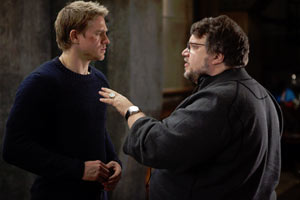
Blu-Ray Special Features Review
Pacific Rim makes its home entertainment release in a nice HD packaging (complete with lenticular cover that shows a Kaiju from one angle and a Jaeger from another) with 2 Blu-Ray discs and a DVD and Ultraviolet copy as well. But the options don’t stop there. There’s a “Limited Edition” Blu-ray 3D + Blu-ray + DVD + UltraViolet Combo Pack that appears to include a statue or some kind of unique packaging, a standard Blu-ray 3D + Blu-ray + DVD + UltraViolet Combo Pack, and a Two-Disc Special Edition DVD + UltraViolet.
The film is probably meant to be watched in 3D (and we did shell out for the tickets to see it on IMAX 3D–and it was pretty awesome), but the film still translates pretty well in 2D high definition. I wouldn’t recom1mend watching it any other way. The 2-disc Blu-Ray set is labeled “Movie” on disc 1 with the Special Features on disc 2. I popped in the bonus disc first to get a head start on the extras, but when I finished, I discovered that disc 1 also has an hour-long collection of “Focus Points” that are making-of featurettes for Pacific Rim.
Blu-Ray Disc One: “Movie”
Focus Points (1:02:26) – Aside from a feature-length commentary from director Guillermo del Toro, there is a collection of “Focus Points” which you can view separately or in a Play All format.
The first segment features the cast talking about director Guillermo del Toro and what it’s like to work with him. We then hear a bit from del Toro about the look of the film and he mentions the colors he used, the deliberate saturation of those colors, as well as the overall look of the movie and its story. The next part is all about the Kaiju. We learn here that “Kaiju” means monster in Japanese, and del Toro mentions adding robots into his own Kaiju movie “is a cherry on top.” Here, del Toro expresses his love for Japanese Kaiju films and how the anime and mecha designs he saw from his childhood inspired Pacific Rim. The following Focus Point is about the Jaeger designs. Here we find out that the robots were designed from the inside out. del Toro and his team cover the color schemes and designs of each Jaeger and how WWII inspired the overall designs. In the end, he wanted to design them to be unique from one another. Next, we see more about the individual Kaiju designing process and how del Toro wanted the Kaiju designs to not reference anything preexisting in the Kaiju lore. They then talk about how tricky it was to film things while getting the scale just right, including the animation for getting the scale of the city debris to be accurate during the process of creating the elaborate fight scenes. The human characters of the film are covered next, and then we hear about all of the training the actors had to endure and the demanding physicality of the roles. We see some behind-the-scenes footage of Raleigh and Mako’s stick fight as well as the intense process of shooting the scenes inside the Jaeger’s cockpit. There’s then a segment about “the drift” and how del Toro designed the look of the characters sharing memories with each other in the process. del Toro also talks about how tricky it was to shoot the transition into Mako’s flashback practically without using CGI. The next Focus Point addresses the look of this future created here, which del Toro calls “goth-tech,” and the crew talks about coloring and aging the sets. This then moves into discussing how many of the sets had been built from scratch, including some whole city blocks, military bases etc. We see the bone slums set, which was made to look like Hong Kong, and more about how the inside of the Jaeger was a real moving set. The featurette begins to wrap up with on-set footage of sets built to resemble the inside and outside of some of the Kaiju, the Tokyo attack and how they’d built part of it as a set and cut back and forth between a real street and a set, and then interviewed composer Ramin Djawadi about needing a bigger orchestra to score this film and all of the various, individual themes he’d created for the different characters.
Blu-Ray Disc Two: “Special Features”
The Director’s Notebook is introduced by a note from director Guillermo del Toro. It’s an interactive “sketchbook” with notes and drawings from del Toro made throughout the planning of the film. There are 9 pages you can flip through using your remote, and they feature videos, translated text pop-ups, and concept art. The first video on the first page is about the people that inhabit this Kaiju/Jaeger-dominated world called “scavengers” and we see the original designs versus the final ones. On page 2, we see some Scavengers concept art. Page 3 has text about the Kaiju coloring and then we see a video about Raleigh’s character arc. There are then some notes about boxing thrown in there. On page 4 we see some concept art of the Kaiju. On page 5 we get a video about how dead, fallen Kaiju became part of the landscape in this world. There’s then a focus on the deep significance of color used in the film (like for Mako and Raleigh). Page 6 features monster poster concept art. Page 7 has del Toro talking about how he wanted to establish the heroes in the film as winners at the beginning and how they grow throughout the film and then win in the end. Page 8 has a video that talks about del Toro’s love of umbrellas and how he uses them with significance in the movie (and how he likes rain in general). Finally, the last page has nothing interactive on it.
Drift Space (5:24) – There are some notes and background history on the characters, like Raleigh, Newt, Mako and a little about Hermann.
The Digital Artistry of Pacific Rim (17:10) shows early animation tests, the technical evolution of the fights between the Kaiju and Jaegers, etc. This is actually a really cool and interesting featurette. (There’s 1 use of “bulls**t” from del Toro in some behind-the-scenes chatter with his crew)
The Shatterdome – Here we have animatics (animated story boards), as well as concept art for Kaiju, Jaegers, costumes, and environments.
Deleted Scenes (3:45) – There are four deleted scenes with a Play All option. The first scene shows Raleigh on the job while working on the wall early on in the film. Next shows Newt and Raleigh talking about the Kaiju. The third is a tiny scene where we see Newt stealing something (it’s not apparent what it is). Lastly, we see the Australian father/son Jaeger team have a verbal fight.
Blooper Reel (3:52) – This blooper reel is a lot of fun. It’s mostly just the actors messing up their lines with the addition of some adlibbing from Charlie Day (Newt).
(There’s 1 “h*ll” here)
– John DiBiase, (reviewed: 10/13/13)
Parental Guide: Content Summary
![]() Sex/Nudity: None.
Sex/Nudity: None.
![]() Vulgarity/Language: At least 1 “S” word, possibly more; 4 “g*dd*mn,” 10 “h*ll,” 5 “a” words, 3 “d*mn,” 2 “S.O.B,” 1 “J-sus,” 1 “For Chr-st’s sake,” 2 “b*tch,” 2 “b*stard,” 2 “cr*p,” 1 “p*ss,” 10 variations of “G-d”
Vulgarity/Language: At least 1 “S” word, possibly more; 4 “g*dd*mn,” 10 “h*ll,” 5 “a” words, 3 “d*mn,” 2 “S.O.B,” 1 “J-sus,” 1 “For Chr-st’s sake,” 2 “b*tch,” 2 “b*stard,” 2 “cr*p,” 1 “p*ss,” 10 variations of “G-d”
![]() Alcohol/Drugs: We see Pentecost pop pills a few times during the movie to combat a condition he suffers from.
Alcohol/Drugs: We see Pentecost pop pills a few times during the movie to combat a condition he suffers from.
![]() Blood/Gore: In a flashback at the beginning of the movie, we see a Jaeger pilot with blood coming from their nose and ears. We later hear that he died; Raleigh has blood on his face, shoulder and on his suit after a Kaiju attack early in the film; Pentecost suffers from nose bleeds on a couple occasions. In one instance, we see blood drops forming on his shoe before the camera pans up to show his face; Geiszler is seen with blood coming from his nose a couple times and has a bloodshot eye at one point; Gottlieb has some blood coming from his nose a bit; We see lots of blue, glowing monster blood on many occasions. In one scene, a Kaiju’s arm is sliced off and falls to the ground. In another scene, its tail is cut off. In another, we see the inside of one Kaiju and a smaller one emerge from the dead carcass of a bigger one; Near the end, we see a man cut through the side of a dead Kaiju with lots of blue blood all over the place.
Blood/Gore: In a flashback at the beginning of the movie, we see a Jaeger pilot with blood coming from their nose and ears. We later hear that he died; Raleigh has blood on his face, shoulder and on his suit after a Kaiju attack early in the film; Pentecost suffers from nose bleeds on a couple occasions. In one instance, we see blood drops forming on his shoe before the camera pans up to show his face; Geiszler is seen with blood coming from his nose a couple times and has a bloodshot eye at one point; Gottlieb has some blood coming from his nose a bit; We see lots of blue, glowing monster blood on many occasions. In one scene, a Kaiju’s arm is sliced off and falls to the ground. In another scene, its tail is cut off. In another, we see the inside of one Kaiju and a smaller one emerge from the dead carcass of a bigger one; Near the end, we see a man cut through the side of a dead Kaiju with lots of blue blood all over the place.
![]() Violence: LOTS of action involving large robots (Jaegers) fighting huge reptilian aliens (Kaiju) throughout the movie. Most of the fights involve buildings, vehicles, etc, being destroyed and smashed to pieces. The aliens are usually brought down in a bloody mess that is a glowing blue color. Some fights involve monster dismemberments like a tail or arm being cut off. One shot shows a large sword cutting open the creature as it passes by the Jaeger. In a longer scene, we see people inside of a dead Kaiju. We also see a smaller Kaiju break through a glowing blue membrane and swallow a person whole (SPOILER: a scene in the end credits shows the man cutting his way out of the wall of this dead creature); We see the Jaeger Gipsy in a fight with a Kaiju in the opening scene that cripples the Gipsy and leaves one of the drivers dead. The remaining driver then pilots the Jaeger to an island where it collapse and he crawls out in a bloody mess (but is still alive); We hear about some workers that died while helping to build a huge wall to keep the Kaiju out. We later see that a Kaiju can easily just bust through the wall to get to the city behind it; Raleigh fights some soldiers with a bo staff to try to find who could be his next partner. So we see several characters beat each other and throw each other to a floor mat. We see an extended fight between Raleigh and Mako; We see a memory of Mako’s where a Kaiju demolished her city, leaving her alone and then the Kaiju chases her; Raleigh and another cadet get into a fist fight before it’s broken up; Hannibal sticks a knife up Geiszler’s nose and we hear him cut him as he pulls it out, but we don’t seem to see any damage to his nose; A Kaiju chases people through the streets so they hide in a tunnel. One later breaks through the ceiling and confronts a lone character. He escapes onto the street but the Kaiju is subdued. We then see the corpse on the ground being harvasted for organs; Several Jaegers get destroyed during the film, killing the human drivers inside; One Jaeger blows up, sacrificing two drivers inside; Another Jaeger explodes, but the drivers escape; and plenty of other monster-related sci-fi violence that involves city destruction, buildings being demolished, etc.
Violence: LOTS of action involving large robots (Jaegers) fighting huge reptilian aliens (Kaiju) throughout the movie. Most of the fights involve buildings, vehicles, etc, being destroyed and smashed to pieces. The aliens are usually brought down in a bloody mess that is a glowing blue color. Some fights involve monster dismemberments like a tail or arm being cut off. One shot shows a large sword cutting open the creature as it passes by the Jaeger. In a longer scene, we see people inside of a dead Kaiju. We also see a smaller Kaiju break through a glowing blue membrane and swallow a person whole (SPOILER: a scene in the end credits shows the man cutting his way out of the wall of this dead creature); We see the Jaeger Gipsy in a fight with a Kaiju in the opening scene that cripples the Gipsy and leaves one of the drivers dead. The remaining driver then pilots the Jaeger to an island where it collapse and he crawls out in a bloody mess (but is still alive); We hear about some workers that died while helping to build a huge wall to keep the Kaiju out. We later see that a Kaiju can easily just bust through the wall to get to the city behind it; Raleigh fights some soldiers with a bo staff to try to find who could be his next partner. So we see several characters beat each other and throw each other to a floor mat. We see an extended fight between Raleigh and Mako; We see a memory of Mako’s where a Kaiju demolished her city, leaving her alone and then the Kaiju chases her; Raleigh and another cadet get into a fist fight before it’s broken up; Hannibal sticks a knife up Geiszler’s nose and we hear him cut him as he pulls it out, but we don’t seem to see any damage to his nose; A Kaiju chases people through the streets so they hide in a tunnel. One later breaks through the ceiling and confronts a lone character. He escapes onto the street but the Kaiju is subdued. We then see the corpse on the ground being harvasted for organs; Several Jaegers get destroyed during the film, killing the human drivers inside; One Jaeger blows up, sacrificing two drivers inside; Another Jaeger explodes, but the drivers escape; and plenty of other monster-related sci-fi violence that involves city destruction, buildings being demolished, etc.
